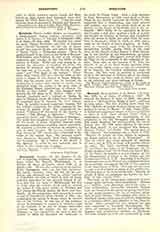

Berruguete, ALONSO, for his mastery of the arts of painting, sculpture, and architecture, sometimes called the Spanish Michelangelo, b. at Paredes de Nava, in Castile, about 1480; d. at Toledo, 1561. He was the second son of the painter, Pedro Berruguete, who was his first instructor. His family, however, chose the law for his profession and obtained for him an official position at Valladolid, the title of which he held for years, probably long after he had devoted himself to art. It is said that the fame of Michelangelo led him to Italy after his father’s death and he entered the school of that great master in Florence and had among his friends Andrea del Sarto and Bandinelli. In the competition with Leonardo he made a copy of Buonarroti’s great cartoon of Pisa. Accompanying his master to Rome, where he assisted him in the Vatican, he was one of the sculptors chosen by Bramante to compete in making a copy of the Laoeoon to be cast in bronze, Sansovino, however, being the winner. On his return to Florence, he was engaged by the nuns of San Geronimo to finish an altarpiece left unfinished at his death by Filippo Lippi. After a long residence in Italy, Berruguete, in 1520, went back to Spain, where he was greatly honored by Charles V, who appointed him a chamberlain, and court painter and sculptor, and gave him much work to do at Madrid, at the Palace of El Prado, and at the Alhambra. With Philip II he continued in favor and became a rich man, married a lady of quality and bought the lordship of Ventosa near Valladolid. After his return to Spain, the artist lived for some time at Saragossa, where he made an altar and a tomb for the church of Santa Engracia. At Valladolid he executed many works for churches and monasteries, notable among which is the high altar of the Church of San Benito el Real, belonging to the convent of the Benedictines, on which he spent six years. Berruguete worked with Felipe de Vigar on the sculptures of the cathedral at Toledo. There also, in the hospital of St. John the Baptist, is one of his finest works, executed when he was nearly eighty years of age, the monument of its founder, the Cardinal Archbishop Juan de Tavera. His best work in painting is considered to be in the cathedral of Palencia and in the church of Ventosa; his best work in bronze and marble in the cathedral and other buildings of Toledo.
AU IUSTUS VAN CLEEF

